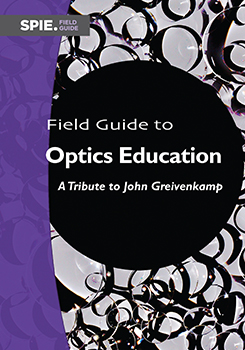|
|
There is More to Teaching Optics and Photonics Than Science and EngineeringAnne-Sophie Poulin-Girard Université Laval, Canada Sometimes, gaining technical skills is not the only, nor the main, goal of education and training in optics and photonics. As educators, we can pursue a variety of goals to help our students become the next generation of scientists and engineers, and science notions are not always the main character of our training efforts. Making sure students would gain technical knowledge was certainly not the only goal of the Photonics Games committees, who have welcomed more than 2500 high school students since the activity was created 14 years ago. In 2008, with a group of friends from my SPIE student chapter, we created the Photonics Games. SPIE student members are great educators, creating countless outreach activities, reaching out to kids and the general public around the world. Held once a year over one or two days, the concept behind the Photonics Games is very simple: in teams of four, high school students compete in various optics and photonics challenges. When we created this activity, we decided on two goals we wanted to reach. The first one was quite standard: increase awareness about the science of light amongst young people and improve their knowledge in the field. The second goal was more ambitious in my opinion. We chose to leverage the fact that STEMs are seen as complicated topics in order to increase the self-confidence of teenage students from underprivileged areas by creating a positive experience in a STEM context. We designed six challenges that each call on different aptitudes: artistic sense, knowledge and memory, physical coordination, 3D visualisation, social interactions and teamwork, and mathematical and logical reasoning. A student who doesn’t have much knowledge of optics might be very good at 3D visualization and would perform on the optical mini-golf course. Since each team was accompanied by a university student volunteer, it was a great opportunity to put the participants in contact with potential role models—an opportunity they might not have had in their normal surroundings. The volunteers also made sure the spirits were high all day long, no matter what the outcome of the challenges was. To maximize the occurrence of STEM-related successful situations during the activity, we had a medal ceremony at the end of the day, which is logical as the Photonics Games are inspired by nothing less than the Olympic Games. There were never real medals, but we decided to present the top three teams of each challenge and give fun science-related gifts to the winners. We also encouraged cheering and expressions of joy, which can become quite loud in the presence of 200 high school students and 70 university volunteers. I have participated in the organization of several editions of the Photonics Games, and the initiative is still thriving to this day. Over the years, high school teachers have told us countless heartwarming stories about their students in the Photonics Games retrospective surveys or during informal conversations. The activity contributed to students becoming more serious towards their studies, a reduction in student absenteeism, an increase in self-confidence, and young people considering technical career paths for the first time. And I cannot recall any teacher who talked about how the Photonics Games significantly impacted their students ability to perform optics and photonics theoretical calculations. That was simply not the main goal. |
CITATIONS
Photonics
Optics education
Engineering education
3D visualizations
3D modeling
Education and training
Scanning transmission electron microscopy


